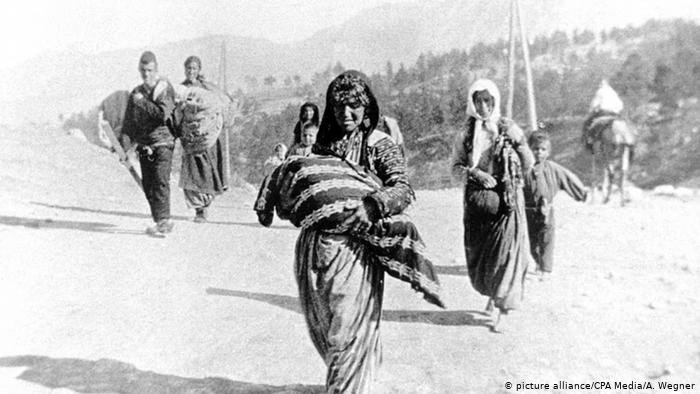MECC: Armenian Genocide Remembrance Day, 1915-2021
Criminality and Denial still in work
Article by Seta Hadeshian*

The 24th of April marks the day of the Armenian Genocide remembrance of 1915. WWI was the right time for Turkey to execute long planned extermination of the Armenian people living in Western Armenia. The strategy was to create a homogenous Turkish state through Turkification of the ethnic minorities within the empire, a policy that culminated in the systematic annihilation of the Armenian population. The policy was carried in two phases. The first phase began on 24 April 1915; the Ottoman government arrested and murdered hundreds of Armenian intellectuals and community leaders, the heartland of Armenian community in Constantinople, modern-day Istanbul. The killing expanded into brutal massacres of the male Armenian population across Ottoman lands and the deportation of Armenian women, children, and the elderly into the Syrian Desert as the second phase. More than 1.5 million Armenians were killed, roughly 70 percent of the total Armenian population in the Ottoman Empire.
In 1915, Armenians were forced out of their 4000 old ancestral homeland, Armenia.
On the 24th of April Armenians all over the world visit the memorials, monuments, holy shrines, erected in memory of the Genocide victims in Yerevan, Lebanon, Argentine, Brazil, Los Angeles, Paris, Athens, as their grandparents did not have marked graves, they disappeared in the sands of the Syrian deserts and in the waters of Euphrates, and every Armenian lights a candle in memory of his/her parents or grandparents.
The failure of the international community to acknowledge the 1915 Armenian Genocide and the ongoing denial of the Turkish state to acknowledge responsibility for the atrocities committed in 1915 in the Armenian Genocide, resulted in the Sumgait massacres that targeted the Armenian population of the seaside town of Sumgait in Azerbaijan in late February 1988. The massacre took place during the early stages of the Karabagh movement. It was directed against the demands of the Nagorno-Karabagh Armenians to separate from Azerbaijan and unify with Armenia. On February 2, 1988, mobs made up of ethnic Azerbaijanis formed into groups attacked, raped and killed Armenians on the streets and in their apartments, committing acts of horrific savagery, mutilating victims by axes. In an overnight 400,000 Armenians became homeless.
There was no intervention on the part of the police to stop the perpetrators. The pre-meditated, organized nature of the massacres was never fully recognized or investigated.
The consequence of such unrelenting impunity was the further bloodbaths of Armenians that took place in Kirovabad (Ganja) in November 1988, in Baku in January 1990. The Killing of a sleeping Armenian soldier, with 16 strokes of axe by Ramil Safaraov, a lieutenant in the Azerbaijan army in February 2004, in the Hungarian capital of Budapest, during training program of “Partnership for Peace” organized by Nato, was the modern day Azerbaijani callous crime. The Hungarian government handed the criminal to Azerbaijan who welcomed as a national hero….
The massacres and criminal acts culminated in the threats of another genocide by modern day Turkey’s leader Erdogan to wipe out Armenians, which followed by the attack on Artsakh (Independent Karapagh) in September 2020 unleashing a military aggression against Artsakh (Karapagh) using Islamist mercenaries killing more than 5000 soldiers, using phosphorous weapons containing chemicals on the population, and occupying 2/3 of independent Artsakh. Usurpation was immediately followed by the application of the policy of destruction and denial, wiping out the cultural heritage, by destroying churches, monasteries, architectural monuments, replacing the names of Armenian Geographical names with Turkish- Azeri names.
Today, hundred and six years later, as Armenians are commemorating their martyrs of 1915 Genocide, a new grief is added to their mourning, the loss of more than 5000 new martyrs and the confiscation of Artsakh.
For how long can the criminal walk freely in the streets? For when is the Nuremberg of the Armenians?
*Seta Hadeshian, Middle East Council of Churches (MECC) Former Diakonia and Social Justice Director, 2004-2017; Presently Executive Assistant to MECC General Secretary

